Rna-binding protein Musashi2: developmentally regulated expression in neural precursor cells and subpopulations of neurons in mammalian CNS
- PMID: 11588182
- PMCID: PMC6763847
- DOI: 10.1523/JNEUROSCI.21-20-08091.2001
Rna-binding protein Musashi2: developmentally regulated expression in neural precursor cells and subpopulations of neurons in mammalian CNS
Abstract
Musashi1 (Msi1) is a mammalian neural RNA-binding protein highly enriched in neural precursor cells that are capable of generating both neurons and glia during embryonic and postnatal CNS development. Here, we identified Musashi2 (Msi2), a novel mammalian RNA-binding protein that exhibits high sequence similarity to Msi1. The Msi2 transcript appeared to be distributed ubiquitously in a wide variety of tissues, consistent with the mRNA distribution of its Xenopus homolog, xrp1. However, the present study revealed cell type-specific and developmentally regulated expression of Msi2 in the mammalian CNS. Interestingly, Msi2 was expressed prominently in precursor cells in the ventricular zone and subventricular zone with the same pattern as Msi1 throughout CNS development. In the postnatal and adult CNS, this concurrent expression of Msi2 and Msi1 was seen in cells of the astrocyte lineage, including ependymal cells, a possible source for postnatal CNS stem cells. During neurogenesis, the expression of both Msi2 and Msi1 was lost in most postmitotic neurons, whereas Msi2 expression persisted in a subset of neuronal lineage cells, such as parvalbumin-containing GABA neurons in the neocortex and neurons in several nuclei of the basal ganglia. Msi2 may have a unique role that is required for the generation and/or maintenance of specific neuronal lineages. Furthermore, in vitro studies showed that Msi2 and Msi1 have similar RNA-binding specificity. These two RNA-binding proteins may exert common functions in neural precursor cells by regulating gene expression at the post-transcriptional level.
Figures

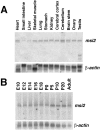


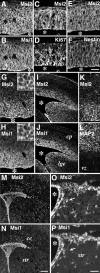



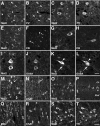
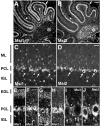
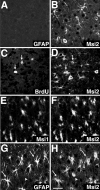
Similar articles
-
Mouse-Musashi-1, a neural RNA-binding protein highly enriched in the mammalian CNS stem cell.Dev Biol. 1996 Jun 15;176(2):230-42. doi: 10.1006/dbio.1996.0130. Dev Biol. 1996. PMID: 8660864
-
RNA-binding protein Musashi family: roles for CNS stem cells and a subpopulation of ependymal cells revealed by targeted disruption and antisense ablation.Proc Natl Acad Sci U S A. 2002 Nov 12;99(23):15194-9. doi: 10.1073/pnas.232087499. Epub 2002 Oct 29. Proc Natl Acad Sci U S A. 2002. PMID: 12407178 Free PMC article.
-
Expression of neural RNA-binding proteins in the postnatal CNS: implications of their roles in neuronal and glial cell development.J Neurosci. 1997 Nov 1;17(21):8300-12. doi: 10.1523/JNEUROSCI.17-21-08300.1997. J Neurosci. 1997. PMID: 9334405 Free PMC article.
-
[Advances in research of Musashi2 in solid tumors].Nan Fang Yi Ke Da Xue Xue Bao. 2022 Mar 20;42(3):448-456. doi: 10.12122/j.issn.1673-4254.2022.03.20. Nan Fang Yi Ke Da Xue Xue Bao. 2022. PMID: 35426812 Free PMC article. Review. Chinese.
-
STARs in the CNS.Biochem Soc Trans. 2016 Aug 15;44(4):1066-72. doi: 10.1042/BST20160084. Biochem Soc Trans. 2016. PMID: 27528753 Review.
Cited by
-
The Role of RNA-Binding Proteins in Hematological Malignancies.Int J Mol Sci. 2022 Aug 23;23(17):9552. doi: 10.3390/ijms23179552. Int J Mol Sci. 2022. PMID: 36076951 Free PMC article. Review.
-
Mechanism of RNA recognition by a Musashi RNA-binding protein.Curr Res Struct Biol. 2021 Dec 14;4:10-20. doi: 10.1016/j.crstbi.2021.12.002. eCollection 2022. Curr Res Struct Biol. 2021. PMID: 34988468 Free PMC article. Review.
-
Knockdown of Musashi RNA Binding Proteins Decreases Radioresistance but Enhances Cell Motility and Invasion in Triple-Negative Breast Cancer.Int J Mol Sci. 2020 Mar 21;21(6):2169. doi: 10.3390/ijms21062169. Int J Mol Sci. 2020. PMID: 32245259 Free PMC article.
-
Association of MSI2 Gene Polymorphism with Age-at-Onset of Schizophrenia in a Chinese Population.Neurosci Bull. 2017 Dec;33(6):731-733. doi: 10.1007/s12264-017-0176-4. Epub 2017 Sep 2. Neurosci Bull. 2017. PMID: 28866849 Free PMC article. No abstract available.
-
Tissue-specific control of brain-enriched miR-7 biogenesis.Genes Dev. 2013 Jan 1;27(1):24-38. doi: 10.1101/gad.199190.112. Genes Dev. 2013. PMID: 23307866 Free PMC article.
References
-
- Akamatsu W, Okano HJ, Osumi N, Inoue T, Nakamura S, Sakakibara S, Miura M, Matsuo N, Darnell RB, Okano H. Mammalian ELAV-like neuronal RNA-binding proteins HuB and HuC promote neuronal development in both the central and peripheral nervous systems. Proc Natl Acad Sci USA. 1999;96:9885–9890. - PMC - PubMed
-
- Altman J. Postnatal development of the cerebellar cortex in the rat. J Comp Neurol. 1972;145:353–398. - PubMed
-
- Amano T, Hamprecht B, Kemper W. High activity of choline acetyltransferase induced in neuroblastoma × glioma hybrid cells. Exp Cell Res. 1974;85:399–408. - PubMed
-
- Barami K, Iversen K, Furneaux H, Goldman SA. Early expression of Hu proteins by newly generated neurons of the adult avian forebrain. J Neurobiol. 1995;28:82–101. - PubMed
-
- Bayer SA, Altman J. Neocortical development. Raven; New York: 1991.
Publication types
MeSH terms
Substances
Associated data
- Actions
- Actions
LinkOut - more resources
Full Text Sources
Other Literature Sources
Medical
Molecular Biology Databases
